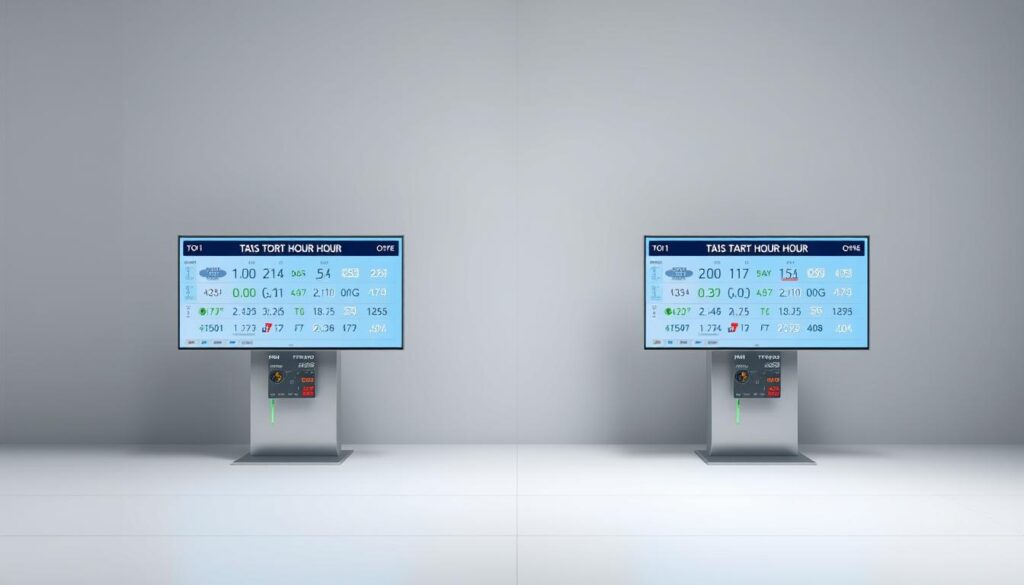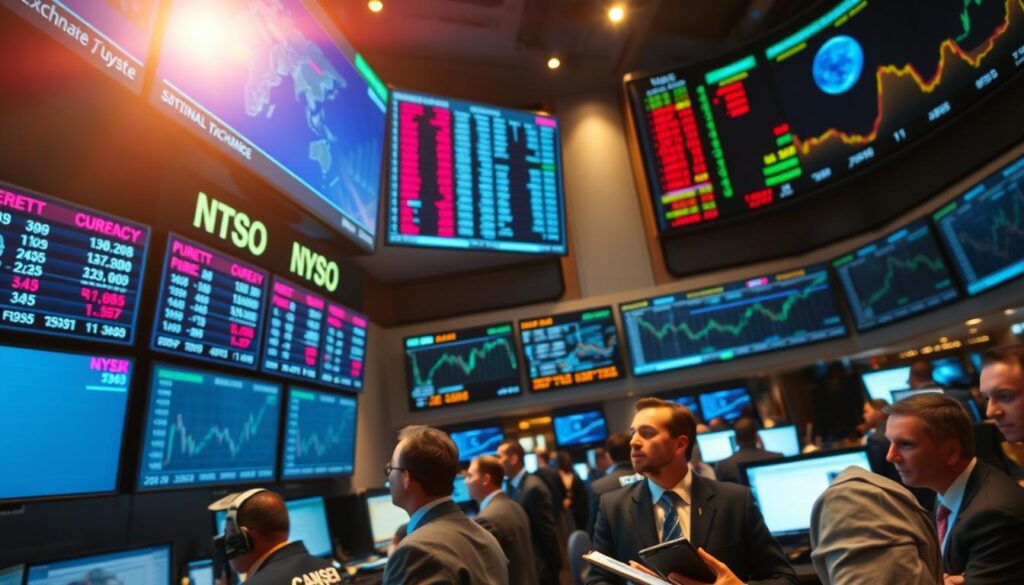Global financial markets offer two dominant arenas for traders: currency exchanges and company shares. Each attracts distinct strategies, risks, and opportunities. The foreign exchange market operates 24 hours a day across global hubs, handling trillions in daily transactions. Meanwhile, stock exchanges like the New York Stock Exchange focus on corporate equities, from tech giants to emerging startups.
Liquidity defines these markets differently. Currency trading thrives on high-volume pairs like EUR/USD, where even small price movements matter. In contrast, stock trading involves ownership in companies such as Apple or Amazon, blending long-term growth with short-term speculation.
This guide explores critical factors like market hours, leverage options, and volatility patterns. It examines how round-the-clock access in one market contrasts with fixed trading sessions in the other. Readers will learn why risk tolerance and time commitment shape ideal choices between these financial landscapes.
Understanding the Basics of the Forex Market
Currency markets form the backbone of global financial interactions, where participants exchange national monies. Unlike traditional exchanges, this decentralized system connects banks, institutions, and individuals through electronic networks. Prices shift based on supply-demand imbalances, economic data releases, and central bank policies.
Major Currency Pairs and Market Dynamics
The EUR/USD and GBP/USD dominate trading volume, reflecting Europe’s economic ties with the U.S. These pairs react sharply to interest rate changes or employment reports. Geopolitical events like trade agreements often trigger rapid valuation swings.
Economic growth disparities between nations also shape trends. For example, a strong U.S. dollar might weaken if Europe announces higher manufacturing output. Traders monitor these patterns to predict short-term movements.
Benefits of a 24-Hour Trading Environment
Round-the-clock operations allow reactions to breaking news anytime. Tokyo’s opening overlaps with London’s morning, creating peak volatility windows. This suits part-time traders who work outside standard business hours.
High liquidity during active sessions enables quick entry and exit points. Such flexibility supports strategies like scalping, where capturing minor price shifts matters most.
Navigating the Stock Market Landscape

Investors encounter a spectrum of opportunities in equity markets, ranging from established giants to speculative ventures. Unlike currency-focused platforms, stock exchanges like the New York Stock Exchange and NASDAQ operate under strict regulatory frameworks. These venues enable ownership in businesses across industries, from healthcare innovators to renewable energy pioneers.
Blue-Chip, Penny Stocks, and Market Diversity
Blue-chip stocks represent industry leaders with proven stability. Companies like Apple and Microsoft dominate their sectors, offering steady dividends and lower volatility. Their market positions often mirror broader economic trends, making them anchors for long-term portfolios.
Penny stocks, priced below £5 per share, attract risk-tolerant traders. These smaller firms may lack consistent earnings but can surge during sector breakthroughs. However, thin liquidity and limited oversight amplify potential losses.
Market diversity allows exposure to multiple sectors simultaneously. A portfolio might combine Amazon’s e-commerce reach with pharmaceutical breakthroughs and clean energy initiatives. This spread mitigates risk when specific industries face downturns.
Regulated exchanges enforce transparency through reporting requirements and trading halts. These safeguards differ from decentralized currency markets, where price movements often reflect immediate geopolitical shifts rather than corporate fundamentals.
Forex vs Stocks: In-Depth Comparison of Trading Features

Cost structures and market dynamics create distinct challenges for traders in different financial arenas. While one market prioritizes accessibility through minimal fees, the other layers costs that can erode smaller accounts.
Spread, Commission, and Trading Costs
Currency platforms like CMC Markets often feature spreads under 1 pip for major pairs, allowing traders to enter positions with minimal upfront expense. These tight spreads suit strategies targeting fractional price shifts. Equity trading, however, combines brokerage commissions with wider bid-ask gaps. A £10,000 stock trade might incur £5-£10 in fees plus 0.1% stamp duty in the UK.
Small accounts face amplified impacts. A £500 forex position with a 0.8 pip spread costs roughly £3, while stock commissions could consume 2-3% of a similar trade. Over hundreds of transactions, these differences reshape profitability margins.
Market Impact and Manipulation
High liquidity in major currency pairs makes price manipulation nearly impossible for individual players. Daily $7.5 trillion volumes dwarf even large institutional orders. Stock markets differ: low-volume equities can swing 10% from a single large trade or speculative rumor.
This volatility explains why short-term strategies dominate currency markets. Traders exploit micro-movements without worrying about sudden gaps during off-hours. Stock investors, particularly in small-cap shares, must account for overnight news risks and regulatory halts.
Trading Hours and Market Accessibility

Financial opportunities wait for no one – but not all markets keep the same schedule. While some platforms lock doors at sunset, others buzz with activity through the night. This difference shapes how traders interact with global opportunities.
Round-the-Clock vs Fixed Sessions
Currency exchanges operate 24 hours daily from Sunday evening to Friday afternoon. A London-based trader can react to Tokyo’s economic data at dawn or New York’s earnings reports after dinner. Meanwhile, major stock exchanges like the LSE and NASDAQ run limited sessions – typically 6.5 to 8.5 hours per weekday.
For example, the London Stock Exchange opens at 8:00 AM and closes at 4:30 PM UK time. NASDAQ follows New York’s 9:30 AM to 4:00 PM EST window. These fixed hours force equity traders to time entries carefully, unlike their counterparts in currency markets.
Global Participation Creates Opportunities
Three major trading sessions – Asian, European, and American – overlap during specific windows. The London-New York overlap (1:00 PM to 4:00 PM UK time) sees 70% of daily forex volume. This surge in activity tightens spreads and improves order execution speeds.
Part-time traders benefit most from flexible schedules. A nurse working night shifts can trade AUD/JPY during Tokyo’s active hours, then EUR/USD after work. Stock investors lack this freedom, often missing moves occurring outside local exchange hours.
Continuous access also stabilizes pricing. Sudden geopolitical events trigger immediate reactions in currency pairs, while equity markets risk gap openings after overnight closures.
Leverage and Risk Management in Different Markets

The power of leverage transforms modest investments into significant market positions. Platforms like CMC Markets allow traders to amplify their exposure, but this tool demands disciplined risk strategies. Understanding how borrowed capital works separates successful traders from those facing margin calls.
Understanding Leverage Ratios and Their Impact
Leverage lets traders control larger positions with minimal upfront capital. In currency markets, ratios often reach 20:1 or higher – a £1,000 deposit controls £20,000. Equity trading typically caps leverage at 5:1, as seen with UK stock brokers. While this magnifies profit potential, losses escalate equally fast.
Consider a £10,000 EUR/USD trade with 20:1 leverage. A 1% price swing creates a £200 profit or loss. The same movement in a 5:1 leveraged stock position yields £50. Higher ratios demand tighter risk controls to avoid account depletion.
Effective Risk Mitigation Techniques
Stop-loss orders automatically close positions at preset levels. For example, setting a 2% loss limit on a £5,000 trade prevents losses exceeding £100. Diversification across currency pairs or sectors reduces reliance on single outcomes.
Three proven methods balance opportunity and safety:
- Position sizing: Risk 1-2% of capital per trade
- Hedging: Offset exposures with correlated assets
- Time-based exits: Close trades before high-impact news events
Platform tools like guaranteed stops (for a fee) lock in maximum loss thresholds. Regular portfolio reviews ensure strategies adapt to changing market conditions.
Volatility and Liquidity: What Traders Need to Know

Market behavior swings between calm and chaos, creating distinct challenges for participants. Price fluctuations define opportunities in fast-paced environments, while stable assets attract cautious investors. Understanding these dynamics separates reactive traders from strategic planners.
Short-Term Movements and the Role of Volatility
Volatility measures price changes over time. Rapid shifts dominate currency markets, where daily swings exceeding 1% are common. Economic reports or geopolitical tensions can move EUR/USD by 100 pips within hours. This suits scalpers and day traders seeking quick gains.
Equities behave differently. Blue-chip shares like Coca-Cola rarely shift more than 2% daily. Their stability appeals to retirement portfolios and dividend-focused strategies. However, speculative tech stocks might mirror currency-like volatility during earnings seasons.
Comparing Liquidity Levels in Forex and Stocks
Liquidity determines how easily assets convert to cash. The currency market’s $7.5 trillion daily volume dwarfs the New York Stock Exchange’s $50 billion average. Major pairs like GBP/USD execute trades instantly, even during news events.
Stock liquidity varies widely. Apple shares trade millions daily, while small-cap companies struggle to fill modest orders. Thinly traded equities risk slippage – buying at higher prices or selling lower than intended.
Three factors shape trading decisions:
- Time horizon: Quick trades thrive on volatility; long holds prefer stability
- Risk appetite: Currency swings demand tight stop-loss orders
- Asset selection: Liquid instruments prevent costly execution delays
Tailoring Trading Strategies for Each Market

Successful traders shape their methods around market rhythms and personal goals. Personality traits like patience or impulsiveness determine whether someone thrives in rapid-fire environments or prefers calculated moves. Financial objectives – quick profits versus gradual wealth-building – further refine this choice.
Matching Methods to Market Mechanics
Currency exchanges reward lightning-fast decisions. Scalpers might exploit a 0.5% euro fluctuation during London-New York trading overlap. Day traders close positions before midnight to avoid swap fees. These approaches capitalize on constant price shifts in liquid markets.
Equity investors often play longer games. A retirement portfolio could hold semiconductor stocks for years, banking on AI growth. Value hunters analyze quarterly reports to spot undervalued companies. Such strategies align with corporate earnings cycles and industry trends.
Three factors guide strategy customization:
- Time availability: Night shifts favor 24-hour currency markets
- Risk thresholds: Tight stop-losses suit volatile conditions
- Research depth: Stock picks demand fundamental analysis
A nurse trading during breaks might prefer GBP/USD’s evening volatility. Meanwhile, a data analyst could excel in evaluating tech stock valuations. Aligning methods with personal strengths and market realities builds sustainable success.
Final Insights for Successful Trading
Choosing between currency and equity trading requires aligning strategies with personal goals. The 24-hour accessibility of one market suits those seeking flexibility, while structured sessions in the other appeal to planned approaches. Costs, leverage, and volatility patterns further shape this decision.
Understanding mechanics like spreads and liquidity prevents unexpected losses. Demo accounts let traders test tactics without financial risk. They reveal how economic updates or earnings reports impact positions in real-world scenarios.
Risk management remains non-negotiable. Setting stop-loss orders and diversifying portfolios protect against sudden market shifts. Continuous learning through trusted analysis ensures strategies evolve with global trends.
Ultimately, success hinges on adapting to changing conditions. Start with paper trading, refine methods, and stay informed. Markets reward those who balance discipline with strategic agility.



